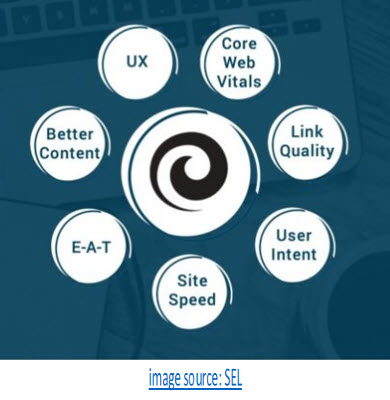
Where did the year go? Specifically, around SEO, do you feel you have kept up pretty well, or has life, non-stop “urgent” marketing projects, and just trying to survive the ups-and-downs from this year kept your focus elsewhere?
If the latter, I got you. In no particular order, check out 10 SEO changes, trends, and updates from this past year.
- Name change—again: Google My Business (formerly known as Google Places) is now Google Business. New functionality, including the ability to add videos, is ready for businesses who want to—and need to— keep leveling up in this area.
- Another name change, but you may not care as much about this one – Google Webmasters became Google Search Central. Their goal is to provide documentation to help people improve the visibility of their site on Google. And did you know even they have SEOs on their team? Very meta.
- Google has been more aggressive about rolling out big changes this year by launching 3 core updates, spam updates, plus many focused updates.
- Page Experience (Core Web Vitals) has rolled out, but SEOs are still not convinced it packed the punch Google said it did.
- In August, Google began rewriting page title tags based on what they thought were “better” title tags. They’ve scaled back on this somewhat due to quality complaints.
- E-A-T has become more concrete with official documentation of what content quality looks like in Google’s Search Quality Guidelines.
- There has been a steady upward trend in SEO spending over the past year (plus). While SEO technically is “free,” it really is not. Search Engine Land says that in 2020 alone, US businesses invested an estimated $79.3 billion to increase their organic footprint.
- Google rolled out continuous scroll in mobile search results back in October. This means the next page of results loads automatically. However, Google said that hasn’t changed anything – they don’t track “pages,” as position is position.
- Passage Ranking was announced early last year – this allows a page to rank for a specific excerpt, or passage, on the page, instead of the entire page ranking. Essentially, Google became better about digging out very specific information within a page.
- Video marketing has continued to be front and center; Google added two new video structured data types in addition to the existing video structured data options. Videos today can appear in Google Search results, video search results, Google Images, and Google Discover.
Phrases and buzzwords I frequently heard over this year were “User Intent,” “Search Intent,” and “Page Experience.”
At the moment, I’m seeing chatter around automation, machine learning, and continued behavioral analytics. As one expert stated, “Brands have to focus on what their customers are doing, how they are doing, and what could be done to make them take action on your site even faster.”
What I wish an SEO 2022 trend would be? Existing content optimization. The “publish or perish” mentality of creating new content just for the sake of it needs to go away, and we need to make what we have better.
What do you think? Do you have a prediction for 2022 or a reflection from the past year? Hit reply and let me know.
SEO |